Instead of putting those small branches, leaves, and grass clippings in bags by the curbside…build a hugelkultur bed.
Simply mound logs, branches, leaves, grass clippings, straw, cardboard, petroleum-free newspaper, manure, compost, or whatever other biomass and organic matter you have available, top with soil, and plant your veggies or perennial plants.
What you’ll get in return is a natural, living garden mound culture that will provide your veggies, fruits, and herbs with a host of beneficial nutrients.
What’s Hugelkultur? Why Hugelkultur?
Hugelkultur (HOO-gul-culture). It’s a German word meaning hill culture or hill mound. The benefits of hugelkultur beds are many. Here are just a few advantages of this gardening technique:
The gradual decay of rotting wood is a consistent source of long-term nutrients for the plants. A large bed might give out a constant supply of nutrients for 20 years (or even longer if you use only hardwoods). The composting wood also generates heat which should extend the growing season.
Soil aeration increases as those branches and logs break down…meaning the bed will be no-till, long term.
The large logs, branches, and other woody material act like a sponge. Rainwater is stored and then released during drier times. Actually you may never need to water your hugel bed again after the first year (except during long term droughts).
Sequester carbon into the soil.
How To Make A Hugelkultur Bed
On a sod lawn, Sepp Holzer (hugelkultur expert) recommends cutting out the sod, digging a 1-foot deep trench, and filling the trench with logs and branches. Then, cover the logs with upside-down turf.

On top of the turf add grass clippings, seaweed, compost, aged manure, straw, green leaves, mulch, etc. From the Permaculture book by Sepp Holzer via Permaculture Magazine.
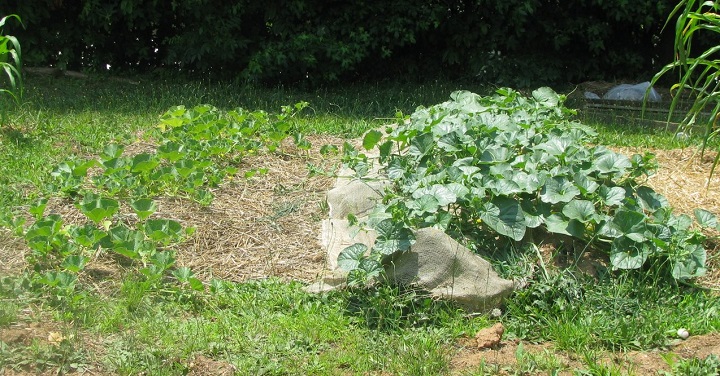
In the photo above, you’ll see a hugel and traditional bed comparison. Cantaloupe plants from the same seed packet. The hugelkultur bed on right was planted two weeks after the traditional bed on left. Photo courtesy of Marcella at Worts and All.

Here’s a steep hugel bed. The more wood and organic matter inside your hugelkultur, the less water it will need; possibly no supplemental water after establishment. With a larger size more heat will be generated and obviously, it will last longer. Photo courtesy of shtf Preparedness.
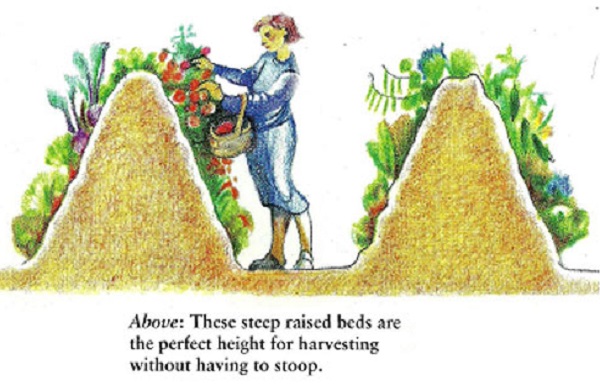
Sepp Holzer recommends steep hugelkultur beds to avoid compaction from increased pressure over time. Steep beds mean more surface area in your garden for plants and the height makes easy harvesting. The greater the mass, the greater the water retention benefits. Image from the Permaculture via Permaculture Magazine.

Height can be decreased by partially burying the bed. Final bed size 75′ long, 4′ wide trench, finished size 6′ at the base, separated by 2′ access paths. Wood height is 8-12″ on tilled clay, finished size 30″ high from bottom of the trench. Rob is making beds for potatoes and he feels they will last up to ten years. Interesting read & photos courtesy of One Straw Rob.

One-plant hugelkultur by Eric Markov. Start small! Whenever you plant add some wood logs and compost. One could also treat an old below ground level tree stump as a hugel, as the old stump will bring up water and decompose, adding nutrients to the soil. Image from Low Cost Vegetable Garden.
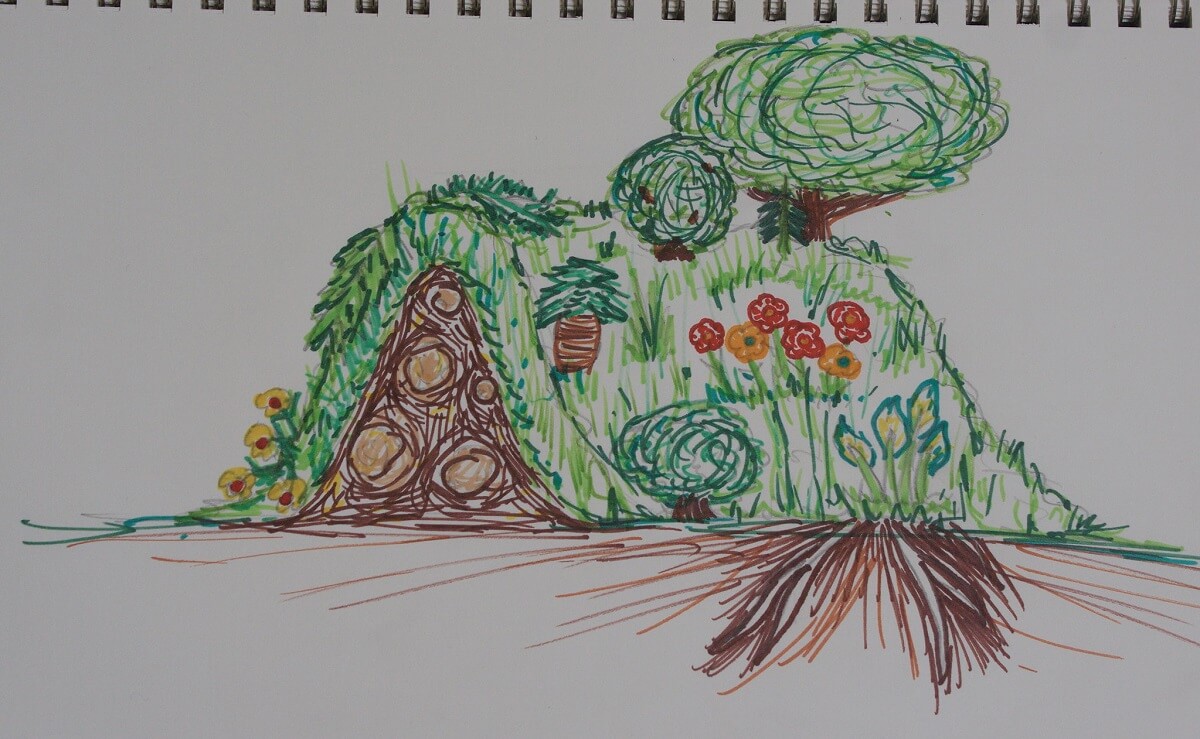
Here’s one permaculturist’s illustration of their thriving hugelkultur bed 3 years after the initial planting.
Ideas For Your Permaculture Garden Bed
- 6 Reasons Why I Chose Clover As A Living Mulch
- Worm Bin Essentials: Getting Started with Vermiculture
- The Basics of Straw Bale Gardening
- Mycelium Guide
14 Of The World’s Best Hugelkultur Beds
1) Hugelkultur In Ontario, Canada
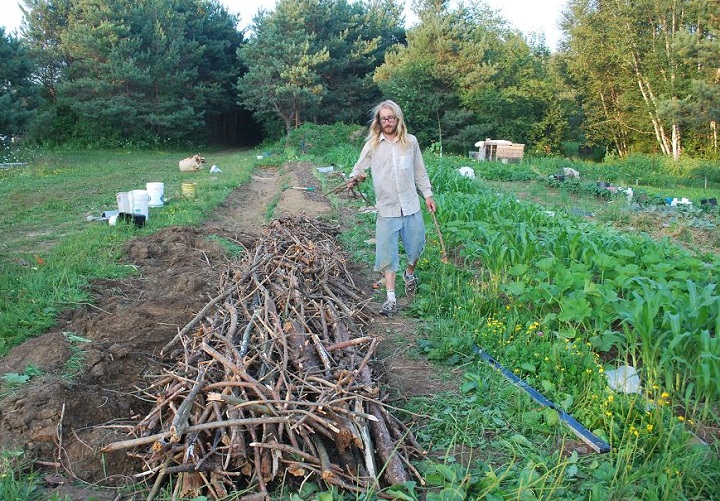
Hugel bed in Ontario, Canada. By Travis Philp. Wood branches stacked 1 foot high.
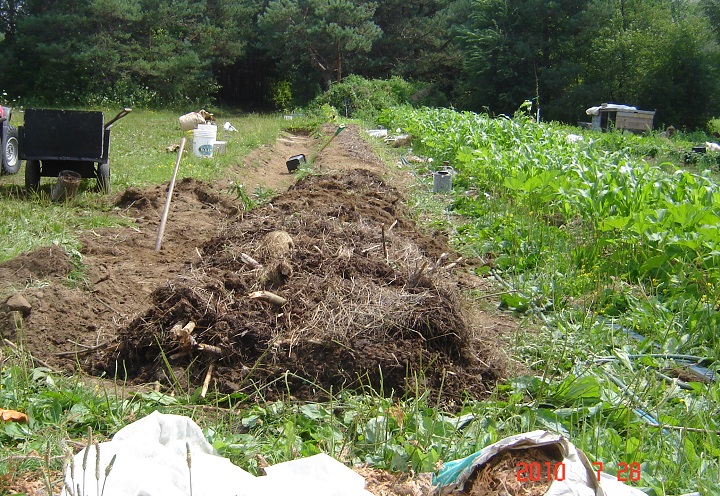
Hugelkultur bed in Ontario, Canada. As above. Branches covered with manure mixed with hay, 4-6″. Sod was packed into random holes.
If you visit greenshireecofarms.com, they also have a video tour of their forest hugelkultur garden.
2) Lettuce-Covered Hugelkultur
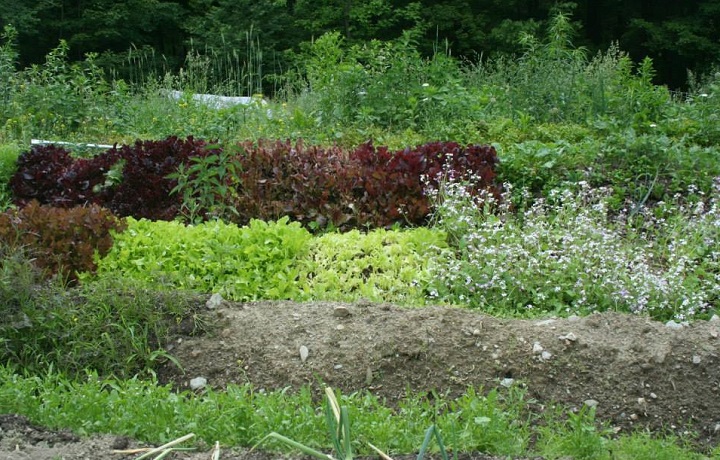
Hugelkultur beds covered in lettuce. More photos, and an explanation of how hugelkulturs work, can be found at Rich Soil.
3) Pallet Hugelkultur
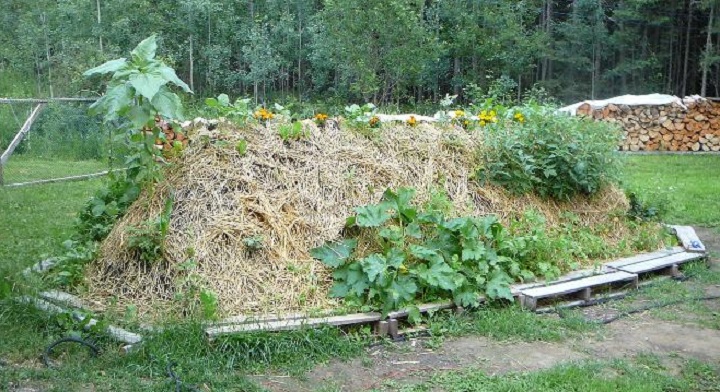
Hugelkultur – nice use of pallets around the periphery. By Mike Sved of northern Ontario. This photo was found on Permies.
4) Log Hugelkultur
Building a hugelkultur can be a great way to use debris from your homestead. These folks turned what was a large, dangerous tree on their property into a thriving hugelkultur bed.
5) Row Of Hugelkultur Beds
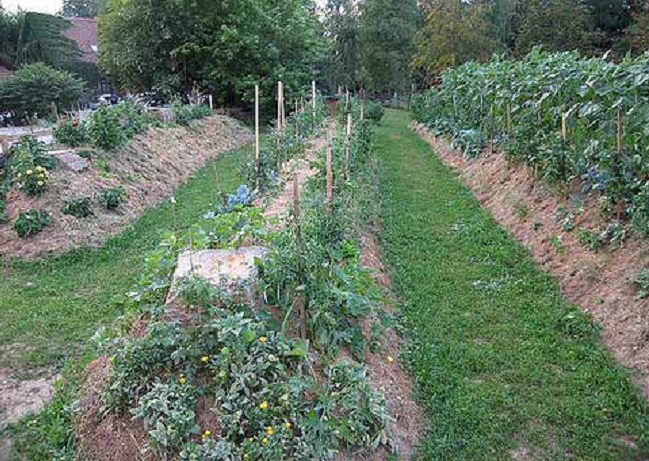
A Sepp Holzer Hugelkultur garden. This photo was found at Holzer Permaculture.
6) Water Directing Hugelkultur
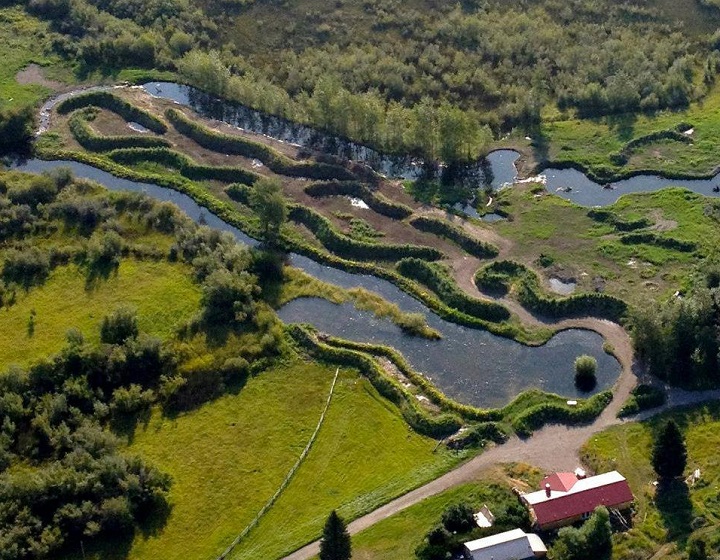
Sepp Holzer uses the terrain, ponds, swales and hugelkultur to direct water to where it is needed on this Montana farm. You can find more on how to work with nature at Holzer Permaculture.
7) Small Hugelkultur Garden
If you don’t have enough room to make a large hugelkultur, this small design is perfect.
8) Framed Hugelkultur Bed
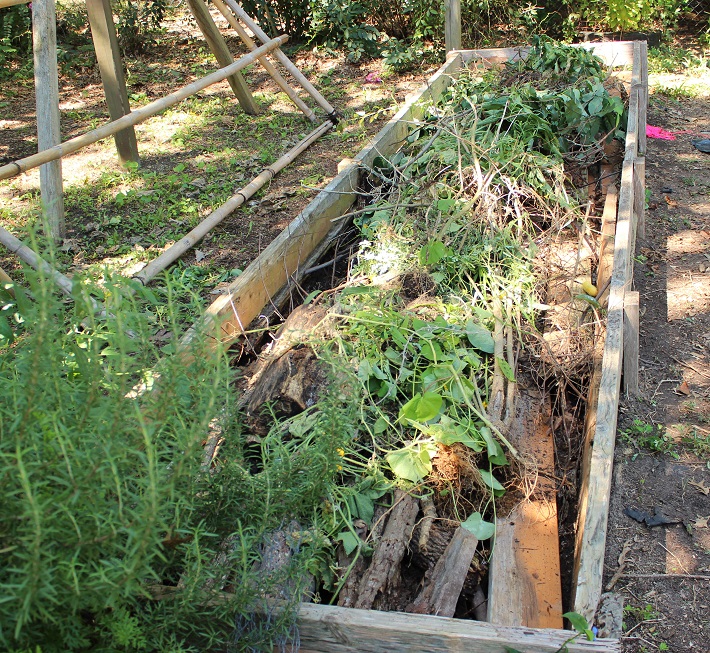
Hugelkultur with frame. The complete garden can be seen at New Wave Gardening Experiment.
9) Dug-Out Hugelkultur

Hugel bed dug in clay with logs put in vertically, next branches and lots of wood chips. The top 6″ will be wood chips and dirt. This bed will store water and give nutrients for many years to come. Photos & more information can be found at Low Cost Vegetable Garden.
10) Branch-Lined Hugelkultur

Small scale hugel bed. As raised beds tend to be a bit drier than traditional beds, a hugelkultur bed is a good solution for a raised bed in a dry climate. This photo was found in an article about evaluating your soil at Homesteading Downsized.
11) Building a Hugelkultur
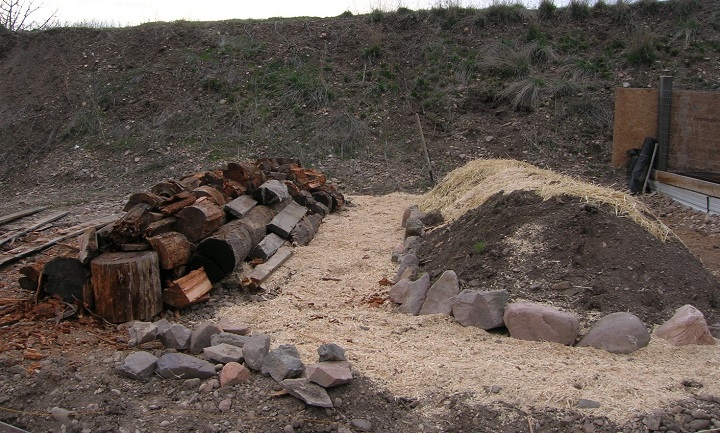
Hugelkultur beds in process by Caleb Larson in Montana. The drier your area, the more wood you need to hold moisture for subsequent years. More examples can be found at Permies.
12) Circular Hugelkultur Bed

This rounded hugelkultur garden is great for being able to access the plants. This design also makes watering easier.
13) Hugelkultur Gardens From Idaho

Hugelkultur beds by Jon in Idaho. You can find out more on this hugelkultur at Permies.
14) Blooming Hugelkultur Bed

Hugelkultur Bed by WSU Master Recycler Composters in Lewis County, Washington. The stones are sure to keep extra heat in the bed. Image originally found at “lewiscountyrecycles.org/projects”
Straw Bale Hugelkultur
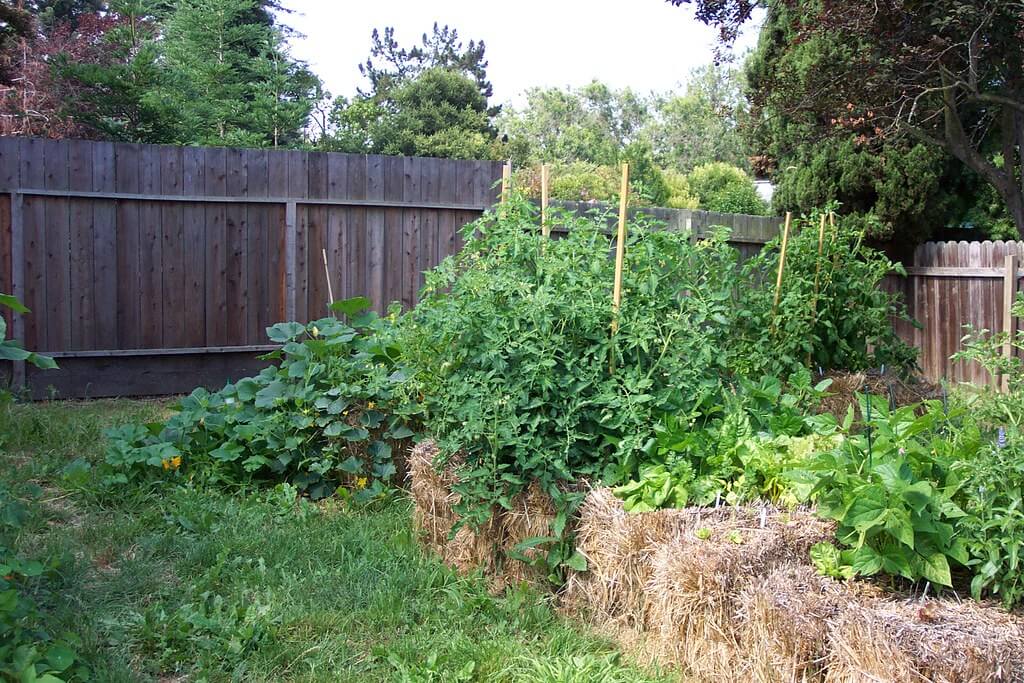
Strawbale gardens require less soil, less water and hold heat. As the straw breaks down nutrients feed the plants. Combining a straw surround with a hugel interior, topped by lasagna layering is an excellent idea for an area with poor quality soil.

A straw bale hugel bed by Jamie in Wisconsin. An instant nutrient-rich border for your hugelkultur. You can also do a hugelkultur right on top of the sod. If excess soil is not available sheet mulch or lasagna garden on top of the logs/branches. Photo originally found at “smalltowngardens.blogspot.com/2012/05/my-own-strawbale-hugelkultur-combo.html”.

Using hay instead of wood will give you a bed that supplies moisture and nutrients for about five years instead of the log’s ten to twenty, plus. By Gerald Benard. To see the entire discussion on hugelkulturs, check out Permies.
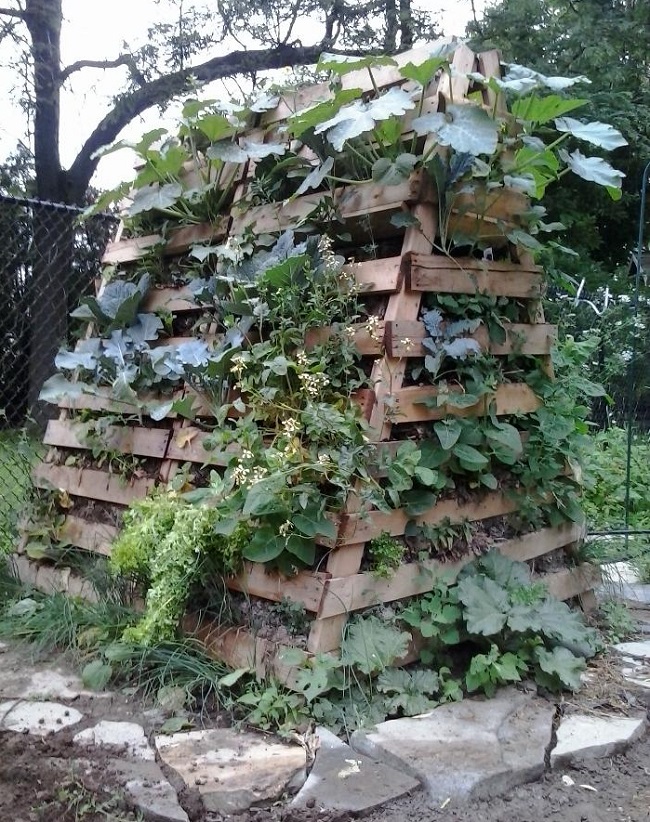
Hugel bed in Ontario, Canada (June 28) by Tim Burrows. Tim surrounded his very tall hugelkultur bed in pallets! Read more about it at Permies.
Sheet Mulching In Hugelkultur
Sheet mulching (lasagna gardening) is like composting in place. Above: just a suggestion as to sheet mulching layers. Nitrogen-rich material such as fresh grass clippings or green leaves put right on the hugelkultur wood would help jump-start the process in your compost pile. Could also include seaweed, straw, dead leaves, leaf mold, etc…

The first year of break down means the wood (and fungi) steal a lot of the nitrogen out of the surrounding environment, so adding nitrogen during the first year or planting crops that add nitrogen to the soil (like legumes) or planting species with minimal nitrogen requirements is necessary, unless there is plenty of organic material on top of the wood.
After the wood absorbs nitrogen to its fill, the wood will start to break down and start to give nitrogen back in the process. In the end, you will be left with a beautiful bed of nutrient-rich soil and improved soil fertility.
Trees That Work Well In Hugelkultur
Hard woods break down slowly and therefore your hugel bed will last longer, hold water for more years and add nutrients for more years. But soft woods are acceptable as well, a softwood bed will just disintegrate quicker.
Mixing woods with softwoods and branches on top, to give off nutrients first, and hardwoods on bottom sounds like a plan if you have access to multiple types of wood. Yet the newly decomposing softwoods at the top will eat up a lot of nitrogen at first, so compensate for that.
Tree Varieties That Work Best
- Alders
- Apple
- Aspen
- Birch
- Cottonwood
- Maple
- Oak
- Poplar
- Willow (make sure it is dead)
Tree Varieties That Work Okay
- Black cherry (use only rotted)
- Camphor wood (well-aged)
- Cedar/Juniper/Yew (anti-microbial/anti-fungal, so use only at the very bottom or unless already well-aged. Cedar should be broken down before new plant roots reach it)
- Eucalyptus (slightly anti-microbial)
- Osage orange (exceptionally resistant to decay)
- Pacific Yew (exceptionally resistant to decay)
- Pine/Fir/Spruce (tannins and sap)
- Red Mulberry (exceptionally resistant to decay)
Tree Varieties To Avoid
- Black Locust (will not decompose)
- Black Walnut (juglone toxin)
- Old Growth Redwood (heartwood will not decompose and redwood compost can prevent seed germination)
The Best Hugelkultur Resources Online
- The Art and Science of Making a Hugelkultur Bed – Transforming Woody Debris
- Hugelkultur: Composting Whole Trees With Ease




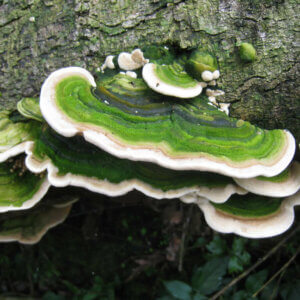



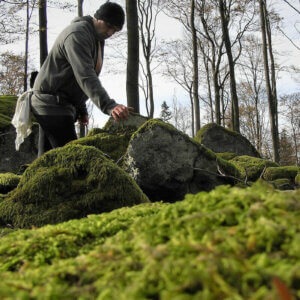

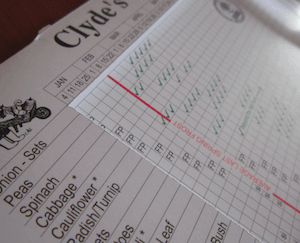




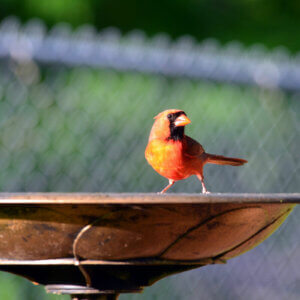
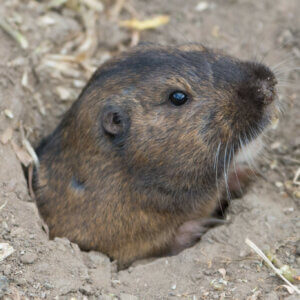
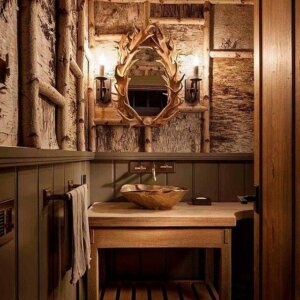

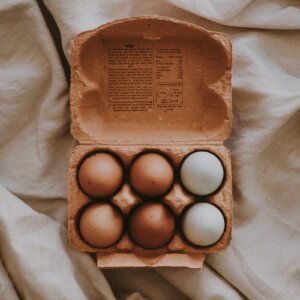
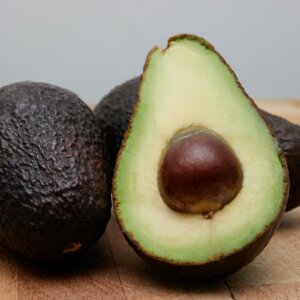

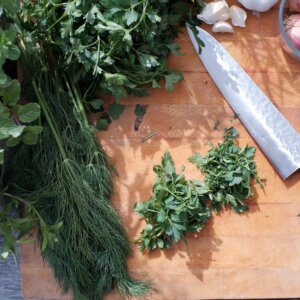


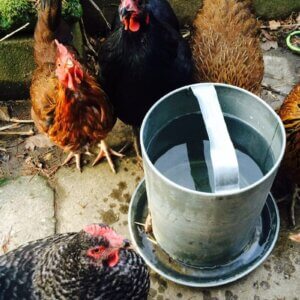


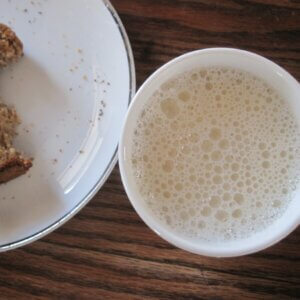
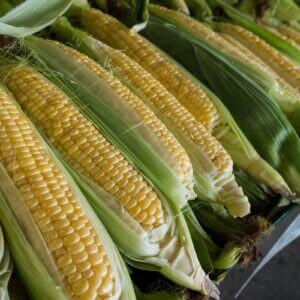
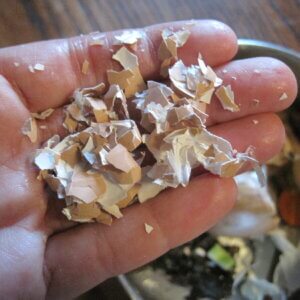

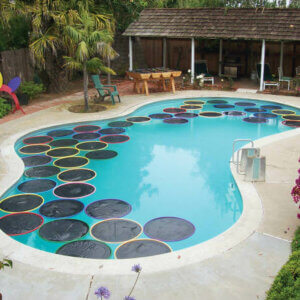


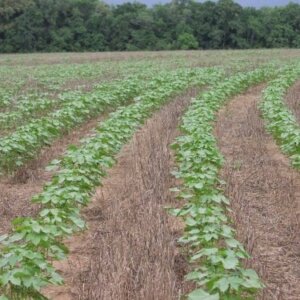

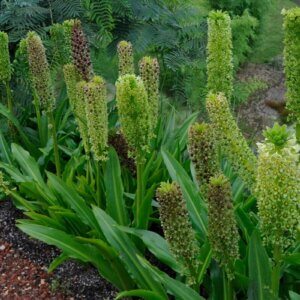
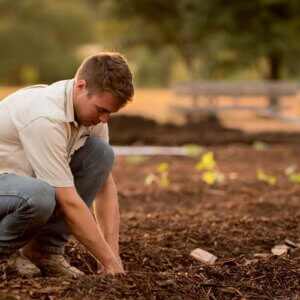


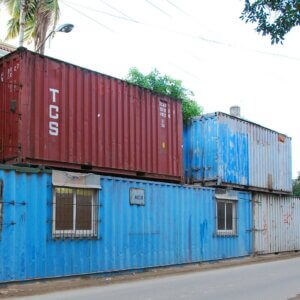
Have been a life long gardener, and have never seen this type of bedding prior..would be perfect for my south Louisiana beds due to the high water level and sandy soil..Will definitely start one this fall.
I’ve just come across your ideas here, and am setting out, at 58, to begin my first veg plot! – I think your ideas are an excellent starting point for me! Thanks.
Great ideas, indeed. I think you mean to say ‘Hügelkultur’ from German ‘Hügelkultur’ (hill culture). Note the Umlaut!
Looks interesting. I’m expanding my garden this year. Ill have to try this. I have a large pile of branches that would be perfect as a start and settle what to do with them. They. Have aged over the winter.
Thanks for the good pictures. That really helps.
Hügelkultur is correct michael, but most keyboards and browsers don’t have an “u umlaut” that is easy to use.
Thank ou for suh useful information!
The Hugelkultur.png that is credited to Permaculture Magazine: permaculturetools.wikispaces is actually – and directly from – the Permaculture book by Sepp Holtzer, page 40.
That is where the photo credit should be….
Hi there, this picture is not about sepp holzer’s place. I’ve been there in 2011 and it’s the Jagawirt, a restaurant + veg garden+pigs etc, that uses permaculture. I have to say in Austria and Germany the hugelbkulture is wide spread and used. Very interesting. In sepp Holzer’s place the terraces were abundantly covered by these high beds, and flourishing.
opps 🙂 forgot to say which picture:
it’s sepp%20fb%20h.jpg the ninth from the top. Nice article!
Newly decomposing woods will eat up a lot of nitrogen. You can compensate for this by adding your own urine to the heap. This is true, I am not takng the piss.
Amazing!
Please let me know whether Alder, Oak and Cedar are good woods for this type of gardening? I read where cottonwood is very good! This is really amazing information! Thank you for providing this site! I am sooooooooo a fan and will spread this information to all the earthy gardeners that I love!! Mug
Hi, Alder and oak are good! Cedar is only good if at bottom of pile, or higher up if already broken down. New plant growth does not like freshly cut cedar. Best!
Was going to fill the pool in with dirt/clay and use as a garden area till I heard about this method. I was wondering if it would be the samething except I would be filling the pool in w/oak, maple, poplar, hickroy, pine as well as decaying wood on my property. I will also be adding straw, cow manure,clay/dirt. Thank you
Now that sounds like it will be one giant hugel bed!
You did not mention how deep your pool is and what it is made of. Also are you in an arid or wet environment?
Do you think the pool will collect too much stagnant water? If it has a vinyl liner I would consider putting some holes on the bottom for drainage. My concern would be the collection of water and then a smell from wood and debris that is rotting too rapidly.
Other than the sitting water issue, sounds a great way to use an old swimming pool.
Another idea would be aquaculture (if you eat fish) I plan to do a post on this in the future.
Thanks for writing. Sounds an exciting project!
Thanks for posting this! Lots of great info and links to other pages. I shared this on my gardening page on facebook, but I was looking for more information on how to use hugelkultur on a smaller scale. Container gardening wouldn’t work, obviously, but I’m hoping to find some info on how to use it in smaller raised beds or less labor intensive methods. Some of my readers wouldn’t have any problem making a traditional hugelkultur bed. It would, however, be too labor intensive for some readers and I was trying to find a way that they could reap some of these benefits as well. I was thinking that old fire wood in the bottom of a regular (flat, not piled up) raised bed would still have some benefits, right?
I think that as long as you use plant friendly wood (not cedar or others listed) or possibly smaller sticks and such, then small scale is fine. There are a few examples on the page. But you are going to need some soil and mulch on top of that wood… I look forward to putting one together myself this spring.
Thanks for writing. Best, Keiren
I have about 5 thuja trees in our back yard we cut down last summer, I am planning on using them in the bottom of my hugelkutur. Do you think these are ok? I also have a huge boxwood that we cut down, can I add that? Thanks!
Hi Jennifer, I have read that Thuja resists decay. So I agree with you, I think Thuja would be best at the bottom of the pile. I am not finding any info hinting that boxwood might not be suitable for a hugel bed. Some say the cuttings might root… But I do wonder why deer won’t touch boxwood…. Maybe you can do a test with a cutting of boxwood placed against a small, sensitive ornamental plant?
I have two acres of walnuts that I prune annually and have access to cow manure. I would like to improve the compacted soil by trenching between the rows of trees and burying my prunings and manure and plant white clover on the slightly raised surface so I can still harvest my walnuts normally. I am hoping this will add to my soils water holding capacity as well as improve drainage to help diminish the effects of phytophthera fungus which seems to thrive in compacted soil. This seems a better option than burning all the attrition. dDo you have any suggestions on how to improve this plan?
I don’t have logs readily available, but I have lots of tree prunings from maple and lilac, maximum diameter 1′. Will these work as a base, or do I need logs?
Wondering if someone can answer a question about my Hugelkulture bed and the process of seeding. When do I seed? After top soil is put on? Before I add the straw? Do I put soil on then seed then more soil then straw? I can’t seem to find the answer.
Please help
Thank you
to Shane Ross Smaller Scale Hugelkultur
I have no idea what I am doing but am a long time gardener. After hearing of this method I started a 6X3′ raised bed in my greenhouse and am really excited about it. Started with a bed of rotted maple firewood, some grass clippings, fresh overgrown spinach, used potting soil from many 15 gallon pots, compost and topped with organic potting soil. I will plant immediately and hope for a winter crop of at least beets, carrots, spinach, micro greens, radishes, Chinese cabbage
etc. Wish me luck. It looks almost foolproof
This looks so amazing to me, I cant believe the word is not all over the front page news. I am re-posting and spreading the word, I have a yard FULL of branches from the last ice storm (waiting for the landlord to get a tree person over there, lol, DUH). Thank you!
Sepp told us that fir/pine is very commonly used by himself and at the Krameterhof, that the tannins break down quite quickly.
I shared this article on my facebook page about hugelkultur.. great job.
Hi there!
Can I use scrap concrete to do a raised bed?
Hi, I came across your website when researching hugelkulture and was wondering if I could get some advice? I live in South Florida where it is hot, humid and rainy. I have an area in my back yard where I had a tree cut down a few years ago and the stump which is beginning to rot still remains. Can I use this as a hugelkulture bed? Also, my soil is terrible here so I will have to purchase some. Any advice on what to get and how high over the stump I should pile the dirt to make this work?
I see bury the stump in soil and plant upon that…
Sure. I have seen that done. I would chop up the stump a bit though. Just to give it more surface to absorb water.
I would say you need at least six inches of soil atop the stump. I would also build up around the sides of the stump with bales of hay or sticks, leaves, etc if you have any available.
I would also mix compost, manure, decomposed leaves etc as my soil…
Hope that turns out well!
This looks a great idea. But in my area also with the wood a great attraction for termites. I might try it anyway.
Also if you have a retaining wall try planting your tomatoes behind it and let them hang over the wall, no need for sakes.
Woops, I left out the L, that should read ‘stakes’
Wonderful article. thanks.
Long lasting way to garden and landscape!
Link exchange is nothing else however it is only placing the other person’s website link on your page at suitable place and other person will also do same in support of you.
Hi
I have a question hope that´s OK 🙂
Why are the Hugelkultur beds often designed in bends forms, is there a differ between a bent and straight Hugelkultur beds and if so what is it ?
I’ve got 40 acres out in the middle of the Nevada desert. Nothing growing except sage brush. I have I want to go gang busters on that land and bring in truck loads of logs and other debris. I would like to plant the biggest mind blowing oasis to help Nevada out with it’s overwhelming desert environment. GO BIG!!
ALTHO I HAVE very good garden beds ,going try a bed this summer for next spring ,looks so inviting ,tu very much, just wondering tho looks like a long way for tomato or lettuce roots to travel,
HONESTLY i feel like this is a ton of work for not much of a yeild. i have yet to see and i have searched, a real good hugel bed that i would want on my property. putting sticks in the bottom is ok but the sides will never really grow well consistantly due to erosion. fun idea but i think bull crap in practice
There are climate based modifications to make it more applicable to specific areas. I have great success with in ground hugels, as do many people in the area of my home in NE FL. Check out the Facebook group Permaculture Jax and look at their files for infood 9n our locally successful technique.
Can Raywood Ash trees be used in Hugel Kultur raised beds?
Hi there
We have a huge mound to the front of our property …it looks like various bits of wood, plants , debris some tyres and random things have gone into making this over the years . Weeds and brambles seem to love this mound. Was wondering if you think it might be worth working with this despite not being constructed from scratch ? Would we need to get rid of the brambles first or can they be composted?
Thanks for your time XXXX
I want to try this at my place with planing shrubs as a hedge along the property line, and was planning to use apple limbs cut off the trees we had pruned and wood chips we got for free from a tree company. The fellow helping us prune said we should not use wood because there is a bacteria that helps the wood break down and if you put a shrub or tree over it and there is a wound in the root, that bacteria or whatever it is can enter the plant and kill it. Any thoughts?
Lots of micro-organisms help wood break down, help leaves break down, etc. Micro-organisms also grow on living roots and are essential for transferring nutrients from the soil to roots. If you had wood pieces contaminated with something like the black knot virus, that would be nasty, but unless he named something specific, it seems a baffling statement.
i discovered your website just today and read this article: it is a very good collection of tips and different kind of hugelbeds
very good…i will keep reading 🙂
Hi there! Great article, thanks. I’ve been looking everywhere to see if Siberian Elm trees can be used in these beds. I see know mention of them here so just wondering if any one has had success with them and /or what your thoughts are. Thanks so much!
I live in a sub-tropical area and have a lot of palm trees. Can I use palm logs in a hugel bed?
Thanks.
I cannot wait until spring to add this to my garden! I have lots and lots of down tree branches etc that will work great. Thanks
Great article and thank you so much for featuring my video from Some Room to Grow! I’m very eager to start growing in the hügelkultur beds this year.